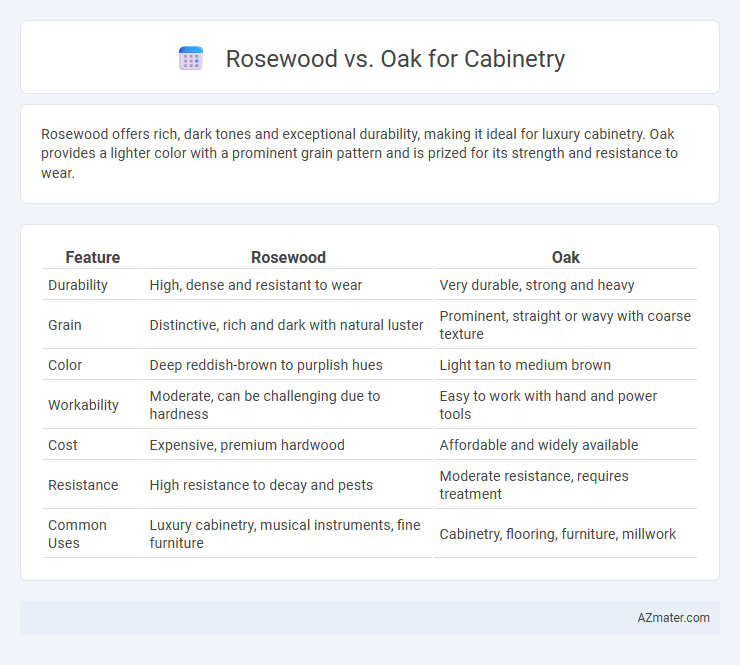Rosewood offers rich, dark tones and exceptional durability, making it ideal for luxury cabinetry. Oak provides a lighter color with a prominent grain pattern and is prized for its strength and resistance to wear.
Table of Comparison
| Feature | Rosewood | Oak |
|---|---|---|
| Durability | High, dense and resistant to wear | Very durable, strong and heavy |
| Grain | Distinctive, rich and dark with natural luster | Prominent, straight or wavy with coarse texture |
| Color | Deep reddish-brown to purplish hues | Light tan to medium brown |
| Workability | Moderate, can be challenging due to hardness | Easy to work with hand and power tools |
| Cost | Expensive, premium hardwood | Affordable and widely available |
| Resistance | High resistance to decay and pests | Moderate resistance, requires treatment |
| Common Uses | Luxury cabinetry, musical instruments, fine furniture | Cabinetry, flooring, furniture, millwork |
Introduction: Comparing Rosewood and Oak for Cabinetry
Rosewood and oak are popular hardwoods used in cabinetry, each offering distinct aesthetics and durability. Rosewood boasts rich, dark hues with intricate grain patterns, making it ideal for high-end, decorative cabinets. Oak provides a robust, lighter-toned alternative with excellent resistance to wear, suitable for both traditional and modern cabinetry designs.
Rosewood Overview: Characteristics and Appeal
Rosewood features a rich, dark hue with intricate grain patterns that create a luxurious and sophisticated appeal for cabinetry. Its natural oils provide durability and resistance to moisture, making it ideal for long-lasting, high-end furniture. Renowned for its rarity and smooth finish, rosewood adds a unique elegance that elevates any interior design.
Oak Overview: Characteristics and Appeal
Oak cabinetry is renowned for its durability, prominent grain patterns, and warm, natural tones that add timeless elegance to interiors. Highly resistant to wear and easy to refinish, oak provides a practical and long-lasting option for kitchen and bathroom cabinets. Its ability to absorb stains and finishes evenly allows for versatile design styles, from traditional to contemporary.
Durability and Strength: Rosewood vs Oak
Rosewood is known for its exceptional durability and high density, making it resistant to wear, dents, and scratches, ideal for cabinetry that demands long-lasting strength. Oak, particularly white oak, offers excellent strength and hardiness, with a dense grain structure that provides strong resistance to impact and moisture. While rosewood tends to be harder and more durable overall, oak remains a reliable and sturdy choice for cabinetry that balances durability with cost-effectiveness.
Aesthetic Differences: Grain, Color, and Finish
Rosewood cabinetry showcases a rich, dark grain pattern with deep reddish-brown hues and natural oily texture, providing a luxurious and exotic appearance ideal for high-end interiors. Oak features a lighter, more uniform grain with prominent rays and flecks, offering a classic, rustic charm in shades ranging from light tan to medium brown. Rosewood's finish tends to be smooth and glossy, enhancing its dramatic coloration, whereas oak's finish highlights its natural grain texture, creating a warm and inviting feel.
Workability: Ease of Crafting and Installation
Rosewood's dense grain provides a smooth finish but can be challenging to cut and shape, requiring sharp tools and experienced craftsmanship for cabinetry. Oak offers superior ease of workability due to its straight grain and moderate hardness, allowing faster crafting and simpler installation. For cabinetry projects prioritizing efficiency, oak is often preferred because it balances durability with user-friendly fabrication.
Cost Comparison: Price of Rosewood vs Oak Cabinets
Rosewood cabinets typically range from $200 to $500 per linear foot due to their exotic nature and durability, making them a premium choice for luxury cabinetry. Oak cabinets are more budget-friendly, averaging between $100 and $300 per linear foot, offering a balance of affordability and strength suitable for most households. Choosing between rosewood and oak depends largely on budget constraints and desired aesthetic, with rosewood commanding higher prices for its rich color and grain patterns compared to the more economical and widely available oak.
Sustainability and Environmental Impact
Rosewood, prized for its rich color and durability, often comes from slow-growing tropical trees facing significant deforestation risks, leading to high environmental concerns and stricter trade regulations. Oak, especially when sourced from sustainably managed forests, offers a more eco-friendly option due to faster growth rates and widespread availability, allowing for better resource replenishment. Choosing oak cabinetry supports sustainable forestry practices and reduces the carbon footprint compared to harvesting endangered rosewood species.
Maintenance and Longevity Considerations
Rosewood cabinetry offers exceptional durability and natural resistance to moisture and insects, resulting in lower maintenance requirements and longer lifespan compared to oak. Oak, while sturdy and widely available, demands regular sealing and polishing to prevent moisture damage and wear over time. Properly maintained rosewood cabinets can last several decades with minimal upkeep, whereas oak may require more frequent refinishing to maintain its appearance and structural integrity.
Choosing the Right Wood: Final Recommendations
Rosewood offers exceptional durability and a rich, dark grain ideal for high-end cabinetry, while oak provides a classic, versatile look with robust strength and excellent resistance to wear. For projects prioritizing luxury and unique aesthetic appeal, rosewood is the preferred choice despite its higher cost and maintenance needs. Oak suits budget-conscious homeowners seeking long-lasting, easy-to-finish cabinetry with timeless appeal in various interior styles.

Infographic: Rosewood vs Oak for Cabinetry
 azmater.com
azmater.com